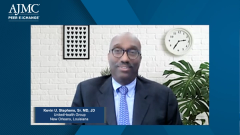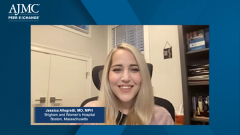
Recurrent CDI: Risk Factors and Outcomes
Experts focus on recurrent clostridium difficile infection to define risk factors and discuss impact on patient outcomes.
Episodes in this series

Transcript:
Neil Minkoff, MD: Dr Gerding, who are the patients at the highest risk for not C diff [Clostridium difficile] per se, but recurrent C diff? That’s one of the things that we worry about a lot clinically. How does the risk of recurrence change with each subsequent episode of C diff infection?
Dale N. Gerding, MD: The risk profile can be defined in patients when they present for recurrence. The critical factors include the age of the patient. Patients over age 65 in particular will have a higher risk of recurrence. If they’ve had a history of C diff infection in the past 6 months, that will increase their risk. If they’re having a severe episode of C diff, that’s a clear-cut factor in increasing their risk of recurrence. The fourth factor is immunosuppression of the patient, which is always a factor in terms of increasing the risk of recurrence. In addition, there’s an unpredictable risk that occurs as the patient is treated: the administration of additional antibiotics. That clearly makes it much more likely that they’re going to have a recurrence. They’re very similar risk factors to why you get C diff in the first place, but then the risk of additional antibiotic use increases the risk of recurrence.
The question about recurrence is that you can get many recurrences. The risk of getting another recurrence goes up with each subsequent recurrence. We’re getting a little better at treating these patients using various kinds of treatment administrations, like tapering and pulsing antibiotics, FMT [fecal microbiota transplantation], and monoclonal antibodies to prevent recurrence. But typically, you’d expect that the recurrence rate is going to increase with the more episodes you have.
Neil Minkoff, MD: When we look at this population, we talked about a number of the risk factors the patient needs to be concerned about, patients with recurrence, and the frequency of recurrence. One of the things we try to do is look at the outcomes for our patient population. Especially for population-based treatment, what are the kinds of outcomes that you’re tracking for a patient population? Dr Abdallah, could you please weigh in on that?
Karina Abdallah, PharmD: Thank you, Dr Minkoff. You already did the lead-in. When you’re looking at population health, it’s important to look at outcomes. The most common outcome is any type of recurrence tied to a secondary inpatient event, and looking at that within probably a 6- to 12-month period. Any type of infection, specifically an infection that maybe wasn’t treated with the newest recommendations from the IDSA [Infectious Diseases Society of America], would be targeted and looked at. Tying that back to not only outcomes but total cost of care from the payer perspective is something that a lot of health plans are starting to target and look at.
Neil Minkoff, MD: Let me open this up to some of the people who are doing more direct patient care. Are you tracking outcomes in your institutions, or is it on a case-by-case basis?
Jessica Allegretti, MD, MPH: We certainly track outcomes at the institution level. We track not only outcomes but also strain levels to see what’s coming through the hospital. Is it 1 clustered event when we see outbreaks, or are these things coming in from the community? I keep track of every C diff infection that goes through our hospital, if you can believe that. We track outcomes, rates of recurrence, and then who ends up on what therapy—for example, how many FMTs are required. These are outcomes we’ve been tracking for years.
Neil Minkoff, MD: Any other thoughts? Dr Gerding, at your VA [Veterans Affairs hospital] facility, do they track outcomes in a similar manner?
Dale N. Gerding, MD: I don’t think we’re tracking outcomes very effectively. One of the big problems with C diff is that you need to follow up on these patients. They need to be advised—which we do—of the likelihood that they’re going to have a recurrence. We’re in the middle of a study to look at the incidence of recurrence in our patients and then enroll them in a recurrence treatment trial. We’re trying to follow these patients with telephone calls alerting them that they might be susceptible to a recurrence, then following up with them and having them call us when they have a recurrence so that we’re on top of it. There’s a problem with follow-up of patients for recurrence because, at least in the past, it hasn’t been widely known how likely it is that a patient is going to have a recurrence.
Transcript edited for clarity.
Newsletter
Stay ahead of policy, cost, and value—subscribe to AJMC for expert insights at the intersection of clinical care and health economics.



































































